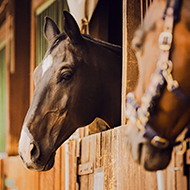Insecticide nets offer protection for stabled horses

Screening horses during transportation and in stables with ITNs would offer significant protection in the event of an outbreak of AHSV in the UK.
Insecticide treated nets can offer significant protection for stabled horses from Culicoides biting midge attacks, new research by the Pirbright Institute shows.
The research, published in Parasites & Vectors, is the first of its kind to investigate the mortality rate of Culicoides when exposed to insecticide treated nets (ITNs) uniting standardised World Health Organisation (WHO) cone bioassay trials. It is also the first to assess how well ITNs can protect horses from Culicoides using field experiments in the UK.
In the study, researchers sought to understand the effectiveness of ITNs following concerns about the threat to the UK from AHSV, which can cause up to 90 per cent mortality in susceptible horses.
They tested seven commercially available pyrethroid insecticides and three repellent compounds commonly used by horse owners to reduce biting rates. This revealed a significant variation in their effectiveness at both causing mortality in exposed Culicoides and reducing bloodfeeding post-exposure in surviving Culicoides.
The study also examined the impact of the repellent compounds on Culicoides survival when it was applied to mesh netting. Although the three products tested had little impact on Culicoides mortality, one product did reduce the bloodfeeding response of exposed Culicoides for up to 14 days after application.
Dr Lara Harrup, a member of the research team based at The Pirbright Institute, said: "This study means that for the first time we have evidence that screening horses during transportation and in stables with ITNs would offer significant protection in the event of an outbreak of AHSV in the UK; particularly if combined with other control measures such as topical repellents and insecticide treatment in stables.
‘"Vaccines for AHSV are available; however none are currently licensed for use within the UK. In their absence, this study provides strong evidence that the use of ITNs, can have a significant impact on reducing contact between Culicoides and horses, and provide a substantial degree of protection against the transmission of AHSV’, she explained.
Dr Simon Carpenter, head of entomology at the Pirbright Institute, and a member of the research team, added: "Another important outcome of this study is that it has highlighted significant variations in the effectiveness of many of the insecticides licensed for amateur use, and further research would help improve these products. The ability of the repellent compounds to reduce the bloodfeeding response of exposed Culicoides also warrants further investigation’.



 Zoetis has launched a new survey to identify management techniques for Equine Herpes Virus (EHV).
Zoetis has launched a new survey to identify management techniques for Equine Herpes Virus (EHV).